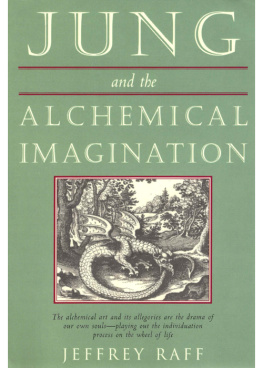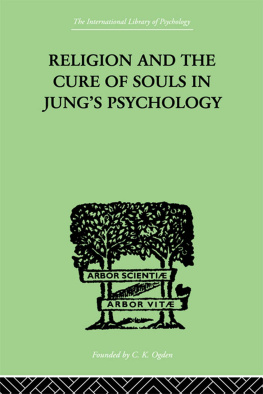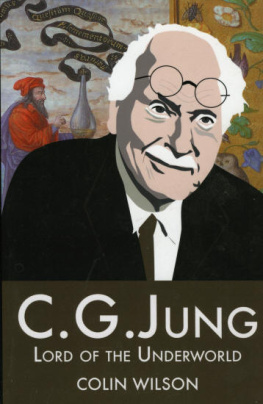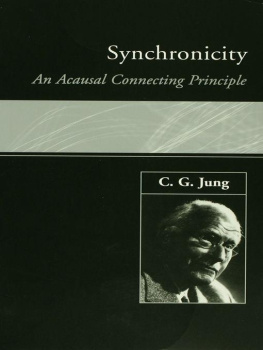List of Illustrations and Tables
Figure 0.1: The Annunciation | xviii |
Figure 2.1: Vault of the Cubiculum of the Annunciation | |
Figure 2.2: Annunciation | |
Figure 2.3: The Annunciation | |
Table 9.1: Pseudo-Dionysiuss view of the celestial hierarchy | |
Figure 9.1: Labyrinth | |
Figure 9.2: The Celestial Rose | |
Figure 9.3: Mandala | |
Figure 10.1: Madonna with the Long Neck | |
Figure 12.1: Yin/Yang | |
Figure 12.2: Opposition | |
Table 13.1: A Comparison of Annunciation and Synchronicity | |
Preface
Fear grips those who doubt that their existence has meaning. The prevailing notion that humans are situated on a dot in the middle of a dark, cold universe leaves people shivering in cosmic insignificance. Many would argue that science and technology have separated individuals from God. Others would say that people have lost their faith. And some would assert that God is dead. Many simply do not know what to believe. Todays self-help industry is a testament to the search for meaning in an age of uncertainty and faltering religious structures.
C. G. Jung was aware of the loss of spiritual meaning in an age of scientific discovery. As he observed in 1934,
Our intellect has achieved the most tremendous things, but in the meantime our spiritual dwelling has fallen into disrepair. We are absolutely convinced that even with the aid of the latest and largest reflecting telescope... man will discover behind the farthest nebulae no fiery empyrean; and we know that our eyes will wander despairingly through the dead emptiness of interstellar space. (1969b, par. 31)
The truth is that technology and science now answer many of the questions that used to be left to God. This development has confounded peoples ability to integrate what is known today with what was once thought.
The disparity between past and present beliefs may be observed in the concept of the angel. There are many who claim that any lingering belief in angels is merely the residue of imaginary or wishful thinking, and there are others who hold that angels (wings, halos, and harps) literally exist. How is one to reconcile such contradictory beliefs?
C. G. Jungs theory of synchronicity (meaningful coincidence) provides a vehicle for the exploration and possible reconciliation of such questions. Rather than echoing the skeptic who says angels cannot exist or the religious enthusiast who affirms their immanence, one might reframe the entire discussion. Like the biblical concept of annunciation, in which an angel delivers a heavenly message to an earthly individual, synchronicity defines the moment at which the eternal touches the temporal.
Admittedly, the concept of the angel and its role in annunciation raises both metaphysical and theological questions which fall outside the realm of conventional academic inquiry. The theory of synchronicity, too, falls mostly outside the scope of conventional academic inquiry because it presents the notion of what Jung called an acausal connecting principle, an idea that contradicts the Western scientific method. Although quantitative methods and conventional academic sources provide much needed insight into these subjects, such methods and sources are limited given the scope of this inquiry.
Until recently, those processes which fell outside the conventional methods have been doubted, discounted, or misunderstood. Yet there is ample evidence to suggest that human potentials or abilities [exist] beyond those that are mediated by conventional sensorimotor processes or conventional energetic and informational exchanges (Braud and Anderson 1998, 39). As Jung suggested, other methods of evaluation should be applied to phenomena such as synchronistic events which fall outside the accepted scientific paradigm (1969l, par. 823). A transpersonal, integral approach not only allows for this, it facilitates such an inquiry.
This approach values objective and subjective methods of inquiry and does not privilege one over the other. Both methods are used where appropriate. A personal experience or narrative sometimes accompanies the scholarship on a given concept in order to illustrate it or provide an alternate perspective from which to consider it.
As the boundaries of academic disciplines give way to interdisciplinary discourse, the conversation expands and new possibilities arise. Individual and collective experiences and ordinary and non-ordinary states provide multiple vantage points for observation and evaluation of phenomena, experiences, and events. Finally, the space necessary for considering the meaning of phenomena from different eras and disciplines in relation to each other opensand the concept of the angel may be explored.
Acknowledgments
The realization of any book is dependent upon those who support the author, her ideas, and the writing and publication processes. Sarah Stanton of Cowley Publishers kindly forwarded my initial inquiry to Lexington Books. Melissa D. Wilks, former acquisitions editor at Lexington Books, pursued the publication of this text. Eric Wrona, current acquisitions editor, and Alison Northridge, editorial assistant, have supported me through the publication process.
Family members and friends have contributed generously to the development of this book. Connie Hood, Dennis Hock, and Wayne Olts have given me permission to share their personal experiences to help demonstrate the power of synchronicity. John Danner created ink and graphite illustrations to enable readers to visualize some of the most important concepts. Other friends, including Lisa Danner, Barbara Davis-Lyman, Charles Van Patten, Jim West, and Connie Zuercher, provided moral support as the ideas in this text took shape over the past ten years. My former students and colleagues at Folsom Lake College and current colleagues at American River College continue to cheer me on.
In addition, I am thankful for the support of Robert McDermott, who has been my advisor since our meeting in 2002, and Richard Tarnas, who initially ignited my interest in synchronicity and helped me refine my understanding of the concept. Finally, I am deeply indebted to Thomas Moore who inspired my inquiry into the role of angels in annunciation and encouraged me to pursue this study.
Introduction
Most Americans, more than two-thirds in fact, believe that angels exist. And more than half of the population professes a belief in a personal guardian angel. Sacred texts describe angelic beings and their unique ability to traverse the expanse between heaven and earth to deliver Gods messages to humans or to intervene on behalf of believers. Religious leaders of many faiths teach that angels are present in the world and active in the lives of believers, though they are careful to remind adherents not to worship angels in the place of God. New Age spiritualists promote methods for communicating with angels to find hope, healing, or financial relief. Alternative thinkers (such as biologist Rupert Sheldrake who asserts that modern physics can provide insight into understanding angels) offer new approaches to this ancient concept. Books on angels fly off shelves as people seek ways to connect to these enigmas of the spiritual realm.
For centuries, spiritual and religious leaders have urged people to recognize that angels exist and are at work in peoples lives. Entire systems of faith have been built on the belief in the message delivered by an angel. A quarter of the worlds populationadherents of Islamaccepts the appearance of the angel Gabriel to Muhammed and the subsequent revelations which have been recorded in the Quran. One of the fastest growing religious sects, the Church of Jesus Christ of the Latter Day Saints, is also based upon the belief that the angel Moroni appeared to founder Joseph Smith and called him to restore the original Christian faith. In fact, Christianity, to which a third of the worlds population professes an allegiance, is based upon the visitation of the angel.










